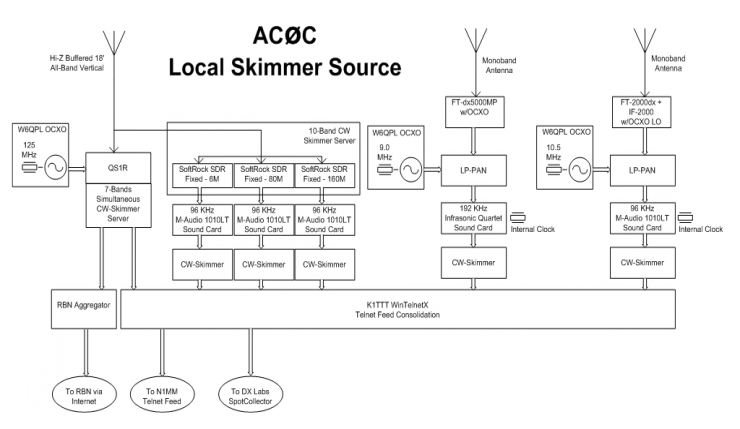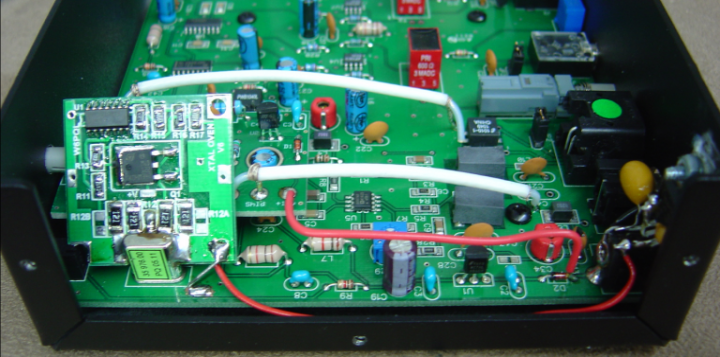In-house spot source for DX and Contesting Locally-generated spots are a great help for both DX-chasing and for assisted-mode contesting. Compared to open spots obtained via the normal cluster or RBN where there is no assurance these stations can actually be heard locally, spots generated from on-site hardware using local antennas are by-definition audible. That means less time spent chasing spots that cannot be heard when working contests, and less time spent camped out in the shack waiting for the DX to "come up" after being spotted by distant east-coast or southern stations. Additionally, in some cases, the local spot can be the first in the region allowing you to be on the DX before the general cluster picks it up. System OverviewThe spot source facility here is a combination of 3 separate systems which work together as follows: 1. The QS1R Quicksilver SDR - skimming 7 fixed bands simultaneously, fed from an all-band vertical.
2. A collection of Soft-Rock fixed-frequency SDR - skimming 3 fixed bands simultaneously, fed from the same all-band vertical. More information on this 10-band skimmer system may be found HERE.
3. A pair of N8LP LP-PAN SDRs, fed from the IF outputs of the two shack rigs, decode the current band band of the rigs - with each shack receiver being connected to the station's primary antenna system (mono-band type at height, for most cases).
The outputs of these 3 systems are consolidated and deduplicated via K1TTT's telnet utility WinTelnetX, providing the streaming telnet source for DX Lab Suite Spot Collector (DX chasing) and N1MM (contesting). The output of the QS1R is additionally fed directly to the RBN network via the Internet from the RBN Aggregator utility. Click on the diagram below for a higher-resolution version. 
The all-band skimmer is located at the very remotest part of the QTH, about 700' from the nearest house in any direction. And while the sensitivity is not as good as a mono-bander at height for a given direction, the antenna's performance overall is excellent as judged by both the actual results in contesting and DXing, and the SNR reported by the system, compared with nearby RBN sources. Construction details of the antenna are provided in more detail HERE. Operation Bands The spot system is setup in one of two different modes depending on the primary task - DXing or contesting. When DXing, all 10 bands (HF+6m) are skimmed. When contesting, the configuration is scaled back to free computer horsepower and only the contest bands of interest are skimmed. Source | When Contesting | When DXing | Antenna | QS1R | Current contest
bands only | 40m, 30m, 20m, 17m, 15m, 12m, 10m | Hi-Z all-band 18' buffered vertical | Soft-Rock Array | Disabled | 6m, 80m and 160m | Hi-Z all-band 18' buffered vertical | LP-PAN #1 | Current FT-dx5000MP band | Current FT-dx5000MP band | Primary station antenna #1 (mono-band) | LP-PAN #2 | Current FT-2000 band | Current FT-2000 band | Primary Station antenna #2 (mono-band) |
Redundant Band ScrubbingWhile the QS1R is assigned 7 band operation, the skimmers tied to the rigs follow the rig's antenna selection, beam direction and band that the operator is working at the moment. This provides redundancy in spot searching between the two sources. The QS1R's all-band vertical captures most of the band spots but may miss the "weak ones" which are perhaps not audible above the noise level of the vertical. These weak-signal spots are filled-in by the rig-attached skimmers, operating with an optimal antenna for the rig's current band, and in the case of weak DX, with beams pointing in the direction of the DX. The combination provides a redundancy for the bands that the rigs are on at the moment, ensuring that no weak spot is missed. The adjustments provided by the CW Skimmer software (operating both on the QS1R and the rig-attached skimmer sessions) can be fine-tuned for spot quality vs. spot speed; tighter enforcement of callsign verification - where contest penalties are grave for busted calls - or loser where feint DX calls and immediate posting of new spots are of greater emphasis. In cases where a Internet-connected cluster source is wanted, a separate connection between the Internet cluster and WinTelnetX can be activated, serving as an additional spot source. This feature is generally not enabled unless out-of-region spots are explicitly wanted. Frequency Stability ConsiderationsEach of the spot sources is subject to some error in the reported spot frequency. This has been minimized for each system as follows. 
1. The QS1R internal clock is on the same PCB as the FPGA. It's frequency moves slightly with ambient temperature, and more significantly with the number of spots being decoded by the FPGA hosted CW Skimmer Server. In contest conditions thousands of spots per hour may be processed by the QS1R - increasing the heat produced by the unit. To eliminate the frequency errors associated with the heat, an external OCXO based on the W6PQL kit and contains a custom ICM crystal built specifically for OCXO use and is optimized for low phase noise. The W6PQL kit is discontinued, however information about it may be found on his web page - click HERE. 
2. The second set of spot sources are taken from the shack rigs via the LP-PAN SDR and PC-mounted sound cards. Each of the parts in the chain contain oscillators which can influence the spot frequency accuracy. Most significantly troublesome was the RF-Space IF-2000 LO which has been replaced with a W6QPL OCXO mounted internally to the FT-2000. More detail HERE. The LO within the FT-dx5000MP is OCXO based and requires no separate accommodation. Finally, each of the LP-PAN SDR units contain the oven-with-feedback-control system from the W6QPL kit internal to the SDR. There is some small additional drift associated with the sound card mounted ADC oscillators but that is a negligable contributor. 
3. There are no special considerations taken for the 10-Band CW Skimmer Server as these spots are not used in contest work. The Skimmer Server sits in a separate room from the shack and has a much more stable temperature condition compared to the other gear. Periodic checks of the spot is sufficient for this source. These measures allow the frequency reported to remain stable, regardless of environmental or loading conditions. Unfortunately the hard resolution limit of the telnet spot system remains 100 Hz, meaning "normal" error is around 50 Hz. So the contest operator or DX chase still needs to fine-tune in some cases to center the signal in the bandpass. The spot system can make point-and-shoot spot chasing pretty simple, but it's not 100% effortless! |